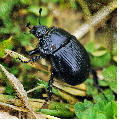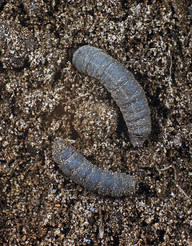Insects and other "creepy crawlies"
| Badger Encounters in the Wild book |
![Badger Encounters in the Wild Jim Crumley [Book]](../../images/badger_encounters_in_the_wild.jpg) |
Superb
book of Jim Crumley's encounters with badgers in the wild in Scotland. The quality of the writing is superb.
A great read. Click here to buy:
Encounters in the wild
|
 Large beetles (such as dung beetles, which are found in cow
pats). Cows compulsively avoid eating any type of dung (their
own or that of any other animal), so much so that around the
edge of a cowpat, a ring of lush green grass will soon appear
- as the cows will not even eat up to the edge of the cowpat.
This gives a chance for various insects (like large dung
beetles to earn a living doing whatever it is they need to do
with cow pats). These dung beetles provide common snack items
for badgers. Careful study of the area around cowpats can
sometimes provide evidence for badgers being active in the
local area! Large beetles (such as dung beetles, which are found in cow
pats). Cows compulsively avoid eating any type of dung (their
own or that of any other animal), so much so that around the
edge of a cowpat, a ring of lush green grass will soon appear
- as the cows will not even eat up to the edge of the cowpat.
This gives a chance for various insects (like large dung
beetles to earn a living doing whatever it is they need to do
with cow pats). These dung beetles provide common snack items
for badgers. Careful study of the area around cowpats can
sometimes provide evidence for badgers being active in the
local area!
 The leatherjacket grubs, larvae (grubs) of crane flies, certain moths, and
beetles - these feed on the roots of
grasses and are dug up by
the badger. Whilst
gardeners may "complain" about a
hole that needs filling in, they may be happier if they
knew that the hole was created by a badger as it dug out and
ate a group of grubs which can become serious garden insect pests.
Leatherjackets can be very damaging in lawns and sometimes kill small plants in
flower beds and vegetable plots by eating roots and stem bases. They are often
more numerous after a wet autumn, as damp conditions favour survival of eggs and
young larvae. Lawn symptoms of leatherjackets include yellowish brown dead
patches; seedlings collapsed having been eaten at soil level; and presence of
leatherjackets in the soil. Reducing the number of leatherjackets within a lawn
often reduces the damage caused by badgers. The leatherjacket grubs, larvae (grubs) of crane flies, certain moths, and
beetles - these feed on the roots of
grasses and are dug up by
the badger. Whilst
gardeners may "complain" about a
hole that needs filling in, they may be happier if they
knew that the hole was created by a badger as it dug out and
ate a group of grubs which can become serious garden insect pests.
Leatherjackets can be very damaging in lawns and sometimes kill small plants in
flower beds and vegetable plots by eating roots and stem bases. They are often
more numerous after a wet autumn, as damp conditions favour survival of eggs and
young larvae. Lawn symptoms of leatherjackets include yellowish brown dead
patches; seedlings collapsed having been eaten at soil level; and presence of
leatherjackets in the soil. Reducing the number of leatherjackets within a lawn
often reduces the damage caused by badgers.
Wasp larvae (badgers often dig out wasp nests so that they
can eat the larvae). Rather curiously, badgers have been seen
to almost ignore a wasps nest over a period of several weeks,
and on one particular night decide to go and open up the nest
and eat the grubs inside. It is thought that the badger picks
a particular night to try a maximise the number and size of
wasp grubs inside. The badger digs through the top of
the wasps nests, tearing the layers off to get to the grubs.
In doing this is avoids the worst of the attacks from the
guard wasps at the entrance
Honey and larvae from
bumblebee nests; although these nests
are often much smaller than wasp nests. There is some evidence
that badgers will attack beehives to get to the honey. When
badgers break into bee nests they typically eat the larvae, pupae, honey and the
honeycomb. Whilst
some such attacks undoubtedly do happen, we suspect the issue is slightly
over-reported; and the main problem regarding bees is to do with
diseases caused by mites and "neonic" pesticides which can
decimate bee populations; rather than damage by badgers.
|
